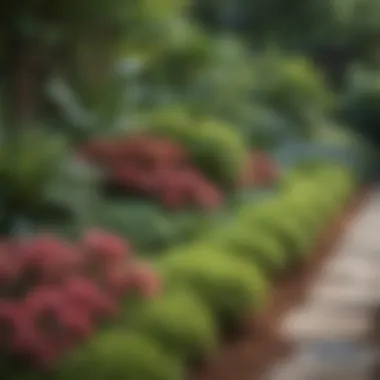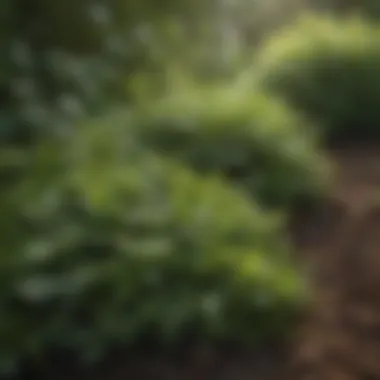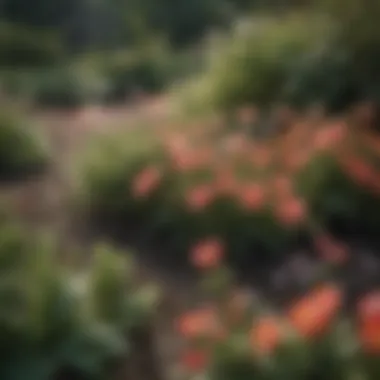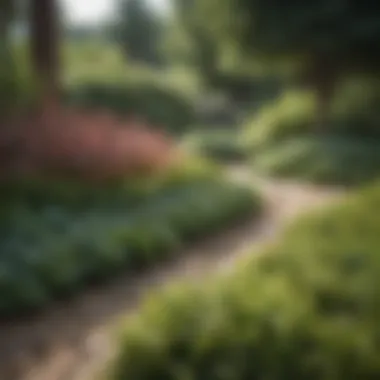Exploring Ground Cover Border Plants for Gardens


Intro
Ground cover border plants are essential elements in landscape design, serving both aesthetic and practical purposes. These plants not only provide visual appeal, but they also play a critical role in soil erosion control, moisture retention, and weed suppression. Understanding the wide array of species available and their specific care requirements is crucial for effective planting and maintenance.
This article will delve into various aspects of ground cover border plants, exploring popular species, pertinent gardening techniques, and design inspirations that can elevate garden aesthetics. Whether you are a homeowner looking to enhance your outdoor space or a gardening enthusiast interested in expanding your knowledge, this exploration of ground cover plants aims to provide valuable insights.
Design Inspiration
Aesthetic Contributions of Ground Cover Plants
The aesthetic role of ground cover plants is undeniable. They can serve as a lush backdrop for taller plants or act as a vibrant palette of colors along pathways. Some species provide consistent and dense coverage, which can substitute for traditional lawns, creating a lower-maintenance alternative.
Current Trends in Landscaping
Recent trends in landscaping emphasize sustainability and native plant usage. Homeowners now prefer to use indigenous species that thrive in their environment, promoting biodiversity. For instance, using ground cover plants like creeping thyme or sedum not only enhances look of a garden but also attracts local pollinators such as bees and butterflies.
Color Schemes and Palette Ideas
When incorporating ground cover plants, the choice of color can significantly impact the overall design. Plants such as ajuga, with its rich purple foliage, provide a striking contrast to greener varieties. Incorporating a mix of textures and colors can lead to eye-catching borders.
Gardening Techniques
Plant Selection and Care
Choosing the right ground cover plant is essential. Factors such as light conditions, soil type, and climate should guide selections. For shaded areas, options like vinca minor can thrive where sunlight is scarce. In contrast, full sun areas may benefit from options such as purple heart or creeping jenny.
Proper care involves understanding watering needs, pruning practices, and potential pest issues. Regular inspection ensures that these border plants remain healthy and vibrant, contributing positively to the garden ecosystem.
Indoor vs. Outdoor Gardening
While ground cover plants are often discussed in the context of outdoor gardening, some varieties can also adapt to indoor environments. Indoor gardening with ground cover plants like pothos or houseleeks can contribute to room aesthetics by adding greenery and improving air quality. These plants offer versatility and can be moved easily to adapt the indoor space's overall theme.
"Ground cover plants provide a seamless transition between different areas of a garden, adding continuity and flow to the landscape."
In summary, understanding the nuances of ground cover plants empowers gardeners and homeowners alike to make informed choices, reinforcing the beauty and functionality of their outdoor spaces. The integration of these plants into residential or commercial landscapes can create a cohesive design that is both practical and pleasing to the eye.
Defining Ground Cover Border Plants
Ground cover border plants serve as a vital component in landscape design. They provide a visual frame and enhance the overall look of gardens and outdoor spaces. Their role goes beyond aesthetics; these plants also ensure ecological balance and contribute to soil health. Understanding the definition and characteristics of these plants is essential for anyone looking to create a functional and attractive garden.
The term "ground cover" refers to low-growing plants that spread horizontally, effectively covering bare soil. These plants provide multiple benefits, including suppressing weeds and preventing soil erosion. They are particularly useful in areas where traditional grass might struggle to grow, such as shaded spots or steep slopes.
With proper selection, ground cover border plants can complement various landscaping styles, ranging from formal to naturalistic designs. They play an essential role in creating visually appealing transitions between different garden elements. Thus, deciding on the right ground cover border plants requires thoughtful consideration of their characteristics and types.
Characteristics of Ground Cover Plants
Ground cover plants possess specific traits that make them suitable for this role in landscaping. Typically, these plants are low-growing, with a height range from a few inches to a foot. This height facilitates easy maintenance and minimizes competition with taller plants for light.
Additionally, many ground cover plants are hardy and resilient. They can endure a variety of environmental conditions, including fluctuating temperatures and varying soil types. Many also have rapid growth rates, enabling them to establish quickly and outcompete weeds. This resilience helps sustain the aesthetic quality of the garden while fulfilling functional roles.
Diversity in foliage is another characteristic. Ground cover border plants come in a range of colors and textures, allowing for creative combinations in design. For instance, plants like Creeping Thyme produce small purple flowers, while Ajuga offers bold foliage and blue spikes.
Furthermore, many ground cover plants also possess scents, adding sensory appeal to gardens. Their flowers can attract pollinators, contributing to the local ecosystem. Overall, these characteristics render ground cover plants an essential component for effective landscaping.
Types of Ground Cover
The variety of ground cover plants is vast and caters to different preferences and requirements. Some are selected for their flowering capabilities, while others are chosen for their foliage or hardiness. Here are some common types:
- Herbaceous Perennials: These plants die back in winter and regrow in spring. Examples include Lamb's Ear and Creeping Jenny.
- Evergreen Varieties: These plants maintain their foliage throughout the year, such as Pachysandra and Vinca Minor.
- Succulents: Species like Sedum work excellently in rock gardens, providing visual interest while requiring minimal care.
- Native Plants: Integrating local species fosters biodiversity and adapts easily to the environment, such as Bluebell or Wild Geranium.
It is crucial to analyze the specific conditions of your landscape before choosing ground cover types. Factors such as sun exposure, soil type, and moisture levels can greatly influence your choices. Ultimately, selecting the right ground cover plants will enhance the garden's visual appeal and functionality.


Importance of Ground Cover Plants in Landscaping
Ground cover plants play a crucial role in landscaping. They add flair and functionality, supporting various aesthetic goals and environmental needs. Understanding their importance reveals why they are considered a staple in both residential and commercial gardens.
Aesthetic Versatility
Ground cover plants enhance visual appeal. They create a unified look across a landscape, serving as a backdrop for larger plants and structures. With options like Creeping Thyme and Ajuga, gardeners can select species that complement their design vision. These plants can fill in gaps, soften edges, and prevent soil erosion at the same time. Additionally, they come in a range of colors, textures, and growth patterns, allowing for creativity in design.
The variety of ground cover plants also ensures they can thrive in various conditions. Some are shade-tolerant, while others prefer full sun, making them suitable for use in diverse environments. Integrating them thoughtfully can create transitions between different zones in the garden.
Ecological Benefits
Ground cover plants contribute significantly to ecological health. They improve soil quality by reducing compaction and enhancing moisture retention. Their roots stabilize the soil, decreasing runoff and promoting water infiltration. This is critical in preventing local flooding and maintaining a healthy water cycle.
Furthermore, many species provide habitat for beneficial insects and support biodiversity. For instance, native ground cover plants often attract pollinators, enhancing overall ecosystem productivity. Employing these plants in landscaping can lead to sustainable practices that align with environmental goals.
Soil Erosion Control
Soil erosion is a significant concern in landscape management. Ground cover plants are instrumental in controlling this issue. Their extensive root systems bind the soil, preventing it from being washed away during heavy rainfall or strong winds. This is particularly important on slopes or in areas prone to erosion.
Moreover, they reduce surface runoff by absorbing rainfall, allowing water to seep into the ground. By dispersing the energy of raindrops, ground cover plants minimize soil disturbance. This underscores their importance not only for aesthetic reasons but also for ecological conservation efforts.
These attributes show how essential ground cover plants are in the landscaping world. They offer beauty, ecological benefits, and practical solutions to challenges like erosion. Investing in careful selection and placement can lead to a thriving and sustainable landscape.
Popular Species of Ground Cover Border Plants
Ground cover border plants serve not only an aesthetic purpose but also a functional role in landscaping. By selecting the right species, homeowners can create visually appealing designs while providing soil stability and biodiversity within their gardens. This section will explore notable ground cover plants, looking closely at their unique qualities and advantages.
Creeping Thyme
Creeping Thyme, known scientifically as Thymus serpyllum, is a popular choice for ground cover. Its low growth habit allows it to spread readily, making it an ideal choice for borders and pathways. One of the key benefits of using Creeping Thyme is its ability to withstand foot traffic. This makes it suitable for walkways or amongst stepping stones.
The aromatic leaves produce lovely purple flowers in the summer, adding a splash of color to garden spaces. It thrives in well-drained sandy soil and prefers full sunlight. Watering requirements are minimal once established, making it a low-maintenance option for busy gardeners.
Ajuga (Bugleweed)
Ajuga reptans, commonly referred to as Bugleweed, is another noteworthy ground cover plant. Its attractive foliage ranges in color from green to deep burgundy, creating visual interest year-round. During spring, Bugleweed offers racemes of blue flowers, which can draw in pollinators.
Ajuga is highly versatile and grows well in a range of soils. It can thrive in both sun and partial shade, making it suitable for various locations in the garden. However, it can sometimes spread aggressively, leading to consideration of its placement carefully.
Moss Phlox
Moss Phlox, or Phlox subulata, is particularly celebrated for its breathtaking blooms and dense coverage. The plant produces a profusion of small, vibrant flowers in shades of pink, purple, and white during the spring. Its low maintenance nature and tolerance to a range of conditions further enhance its appeal.
Moss Phlox is often used in rock gardens, along pathways, or as a border plant. It prefers well-drained soils and enjoys sunny locations. Once established, it requires little watering. This plant's thorough coverage aids in suppressing weeds, thus lessening garden maintenance efforts.
Sedum Varieties
Sedum, commonly known as Stonecrop, encompasses various species making it adaptable to multiple environments. These succulent plants are valued for their drought resistance, making them perfect for xeriscaping or dry garden areas. Popular choices include Sedum spurium and Sedum album.
Sedums also offer an array of colors and textures. Their flowers, typically star-shaped, attract pollinators and inspire additional interest in garden layouts. They thrive in well-drained soil and prefer full sun to partial shade. Minimal watering makes them an excellent option for resource-conscious gardeners.
"The selection of specific ground cover plants not only enhances the aesthetic quality of a garden but can also significantly reduce maintenance efforts. As such, careful consideration of each species is paramount."
Placement and Design Considerations
Placement and design considerations are critical when it comes to incorporating ground cover border plants into any landscape. The thoughtful positioning of these plants can transform a garden's aesthetic and functional aspects. The right plants can enhance visual appeal, improve biodiversity, and contribute positively to the environment. It is not merely about choosing colors or textures; it involves understanding how these ground covers interact within their designated space.
Choosing the Right Location
Selecting the appropriate location for ground cover border plants is essential. The chosen site must align with the growth requirements of the specific species. Factors such as sunlight exposure, soil condition, drainage capabilities, and moisture levels significantly impact plant health.


- Assess sunlight availability: Most ground cover plants prefer either full sun or partial shade. Knowing this can guide the selection process.
- Evaluate soil type: Different species thrive in varying soil types. For instance, some prefer sandy soil, while others grow best in clay.
- Check drainage: Good drainage prevents waterlogging, which can affect root health. Ensure that the site allows excess water to escape effectively.
Considering these factors improves the likelihood of successful growth and a vibrant landscape.
Complementing Existing Plants
Integrating ground cover plants with existing flora is another factor worth considering. The growth habits, colors, and textures of surrounding plants can significantly influence the overall design. Ground cover plants should complement their neighbors while filling in gaps in the landscape.
- Growth patterns: Choose ground covers that won't outgrow or overshadow taller plants. Shorter ground covers are ideal near flowering perennials or shrubs.
- Color coordination: Opt for plants that harmonize with existing blooms or foliage. This choice enhances the visual appeal of the garden.
- Texture contributions: Mix plants that offer different leaf shapes and sizes. This diversity provides intrigue and depth to the garden.
By carefully selecting ground cover species that work well with other plants, you can create a more cohesive and balanced landscape.
Creating a Cohesive Look
A cohesive look in landscape design increases visual unity and tranquility in outdoor spaces. Ground cover border plants play a key role in achieving this effect. When designed thoughtfully, they can serve as a unifying element across various garden areas.
- Consistent themes: Use similar foliage shapes or colors throughout. This strategy aids in creating a unified appearance.
- Flow between spaces: Plan where ground covers will spread to ensure they link different sections of the garden fluidly.
- Layering plants: Combine taller borders with lower ground covers. Such layering results in an organized yet dynamic landscape that draws the eye and encourages exploration.
Ground cover plants can thus form a beautiful foundation, linking different areas of a garden into an inviting whole.
"The thoughtful design of ground cover plants not only satisfies aesthetic preferences but also enhances environmental health."
Cultural Requirements of Ground Cover Plants
Understanding cultural requirements of ground cover plants is vital for successful gardening and landscaping. These requirements encompass various factors that influence plant health, growth, and overall performance. Addressing these elements can lead to lush, thriving ground cover that enhances landscape aesthetics and functionality.
Light Conditions
Light conditions play a critical role in the growth of ground cover plants. Each species has a specific light preference, ranging from full sun to full shade. For instance, creeping thyme thrives in full sun, while ajuga, or bugleweed, does well in partial shade or full shade.
When determining the placement of your ground cover plants, consider the following:
- Sunlight Availability: Observe how much sun different areas of your garden receive throughout the day.
- Plant Selection: Choose plants that suit these light conditions. Selecting the right plants ensures vigorous growth and minimizes stress on the plants.
It is crucial to monitor and adjust the location of certain ground covers to match their light needs as they grow, ensuring long-term sustainability.
Soil Types and pH Levels
Soil composition and its pH level are critical for ground cover plant health. Different plants thrive in various soil types, including sandy, clay, or loamy soils. For example, sedum varieties prefer well-drained, sandy soil, whereas moss phlox flourishes in rich, organic substrates.
Understanding soil pH is equally necessary. Most ground cover plants generally prefer slightly acidic to neutral pH levels (around 6.0 to 7.0), but some species have distinct preferences.
- Testing Soil: It’s advisable to conduct a soil test to determine both the type and pH levels before planting.
- Amending Soil: Depending on your findings, you may need to amend the soil with organic matter or fertilizers to create optimal conditions for your selected ground cover.
Watering Needs
Watering constitutes a fundamental aspect of caring for ground cover plants. While some of these plants are drought-tolerant, others require consistent moisture to thrive. For instance, ajuga needs regular watering, especially during dry spells, whereas creeping thyme can withstand longer periods without water.
Here are some key considerations regarding watering:
- Establishment Phase: Newly planted ground covers generally need more frequent watering to establish roots.
- Ongoing Maintenance: Once established, adjust the watering frequency based on rainfall and individual plant needs. A good approach is to water deeply and less frequently to encourage deeper root growth.
Overall, understanding the cultural requirements of ground cover plants is essential for creating a vibrant and healthy garden. By addressing light conditions, soil types and pH levels, and watering needs, gardeners can cultivate thriving ground covers that transform their landscapes.
Maintaining Ground Cover Border Plants
Maintaining ground cover border plants is essential for ensuring their health, aesthetic appeal, and functional contributions to landscaping. Proper maintenance can lead to lush, vibrant growth that enhances the overall beauty of any garden space. The significance of maintenance extends beyond appearance; it includes promoting plant longevity and preventing common issues like pest infestations or diseases. Through adequate care, one can maximize the benefits that these plants offer, such as erosion control, soil improvement, and habitat for beneficial wildlife.
Pruning and Shearing Techniques
Pruning and shearing are critical aspects of maintaining ground cover plants. Regular trimming helps control growth, encourages fuller foliage, and keeps the plants tidy. For species like creeping thyme or ajuga, light shearing can stimulate new growth and flowering.


- Timing Matters: Prune in early spring or late summer, depending on the species. Early spring helps remove winter damage, while summer shearing promotes fresh growth.
- Tools: Using sharp, clean tools prevents damage and infection. Hand pruners work well for small plants, while hedge shears are effective for larger areas.
- Technique: Always cut just above a leaf node to encourage new growth. Avoid cutting too drastically, as it may shock the plant.
Adopting these pruning techniques can greatly enhance both the health and aesthetics of your ground cover plants, ensuring they contribute positively to your landscaping throughout the growing season.
Fertilization Practices
Effective fertilization practices are vital for the growth of ground cover plants. These plants often thrive in less nutrient-rich soils, but periodic fertilization can enhance their vigor and color. Here are some considerations:
- Type of Fertilizer: Use a balanced slow-release fertilizer to avoid burning the plants. Organic options like compost can also improve soil structure.
- Testing Soil: Before applying fertilizers, it is advisable to test soil quality. Knowing the pH and nutrient levels can guide correct fertilization strategies.
- Application Timing: Fertilize in early spring as new growth begins. This timing aligns with the plant's natural growing cycle.
Fertilizing ground cover border plants correctly will lead to lush greenery and vibrant colors, enhancing their role in your landscape design.
Pest and Disease Management
Pest and disease management is crucial in maintaining healthy ground cover plants. Although these plants generally resist pests, infestations can happen. Proactive measures are essential to safeguard them.
- Regular Inspection: Periodically check for signs of pests like aphids or spider mites. Look for unusual discoloration or deformities in leaves.
- Organic Solutions: If pests are detected, consider organic pesticides or insecticidal soap to minimize chemical exposure.
- Disease Awareness: Familiarize yourself with common diseases such as powdery mildew. Proper spacing and air circulation can reduce fungal infections.
By staying vigilant and employing effective management techniques, one can protect their ground cover plants from potential threats, ensuring a vibrant and resilient border in the garden.
Environmental Considerations
Ground cover border plants provide more than just aesthetic contributions to landscaping; they also play significant roles in the environmental health of gardens and surrounding areas. Understanding the environmental considerations linked with these plants is vital for creating sustainable and thriving landscapes. This section will explore three primary aspects: sustainability, the importance of native species for biodiversity, and the management of invasive species.
Sustainability Aspects
Sustainability is an essential theme for gardening and landscaping practices. Using ground cover plants contributes to ecological balance by enhancing soil health, reducing water runoff, and promoting biodiversity. Sustainable practices include selecting plants that require minimal resources, such as water and fertilizer.
- Conserving Water: Many ground cover plants are drought-resistant, making them ideal for regions with limited water supply.
- Soil Health: These plants help in building soil structure and preventing erosion. Their roots stabilize the soil, reducing the likelihood of runoff.
- Carbon Sequestration: Ground cover can capture carbon, which contributes to lowering greenhouse gases in the atmosphere.
Implementing sustainable practices with ground cover plants can lead to a lower carbon footprint and promote a healthier ecosystem.
Native Species for Biodiversity
Incorporating native species into landscaping is crucial for sustaining local biodiversity. Native ground cover plants are well-adapted to the local climate and soil conditions. This adaptability enables them to thrive with less maintenance, such as watering and fertilization. Here are several benefits:
- Attracting Pollinators: Native plants support local pollinators, such as bees and butterflies, which are essential for healthy ecosystems.
- Providing Habitat: They offer habitats for various wildlife, contributing to a balanced ecosystem.
- Reducing Invasive Species Spread: Native plants can outcompete invasive species, preventing them from taking over garden spaces. This leads to stronger ecosystems.
Choosing native ground cover options not only beautifies spaces but also enriches the ecological fabric of the surrounding area.
Dealing with Invasive Species
Invasive plants pose a serious threat to local ecosystems, often outcompeting native flora for resources. Unchecked, these invasives can drastically alter habitats and reduce biodiversity. Gardeners must be proactive in managing these species. Some considerations include:
- Identification: Recognizing invasive species early is vital. Familiarize yourself with local invasive plants and monitor your garden for signs of growth.
- Preventative Practices: Use mulch and well-maintained ground cover to suppress weed growth. This helps to reduce the chances of invasive plants taking root.
- Removal Strategies: For invasive species already present, consider manual removal or targeted herbicide application, keeping ecological impacts in mind.
Invasive species management is an ongoing process, and awareness helps maintain the integrity of local ecosystems.
"Integrating environmental considerations into landscaping can yield significant benefits for both the individual gardener and the broader ecological community."
End
In this article, we have examined the significant role of ground cover border plants. These plants not only beautify gardens but also provide practical benefits. Understanding their characteristics and requirements is essential for successful gardening. The selection of suitable species can enhance the aesthetics while ensuring plant health.
Summarizing Key Points
Ground cover border plants are diverse, ranging from creeping thyme to ajuga and moss phlox. Each type offers unique attributes, making them suitable for different landscaping needs. Some of the main points include:
- Aesthetic Appeal: Ground cover plants create a visually pleasing landscape. They can fill empty spaces, soften edges, and complement existing flora.
- Ecological Advantages: These plants contribute positively to the ecosystem. They help in soil stabilization, support wildlife, and improve air quality.
- Maintenance Needs: Regular care tailored to specific plant types is necessary. This includes proper watering, pruning, and pest management.
- Environmental Impact: Using native species promotes biodiversity and minimizes the risk of invasive species taking hold.
Future Trends in Ground Cover Plant Selection
As gardening practices evolve, new trends emerge in the use of ground cover border plants. Future selections may focus on:
- Sustainability: Homeowners are increasingly interested in eco-friendly options. This means more emphasis on native species and low-maintenance varieties.
- Diverse Planting Strategies: Mixing different types of ground covers can create dynamic landscapes. This not only enhances visual interest but can also improve resilience against pests and diseases.
- Technological Integration: Advancements in gardening technology, such as moisture sensors and climate-resilient plant types, may shape future planting decisions.
"Choosing the right ground cover plant can transform ordinary spaces into remarkable landscapes."
Understanding these trends can help gardeners plan better. By selecting the appropriate plants, they can contribute to sustainable practices while achieving beautiful results.



